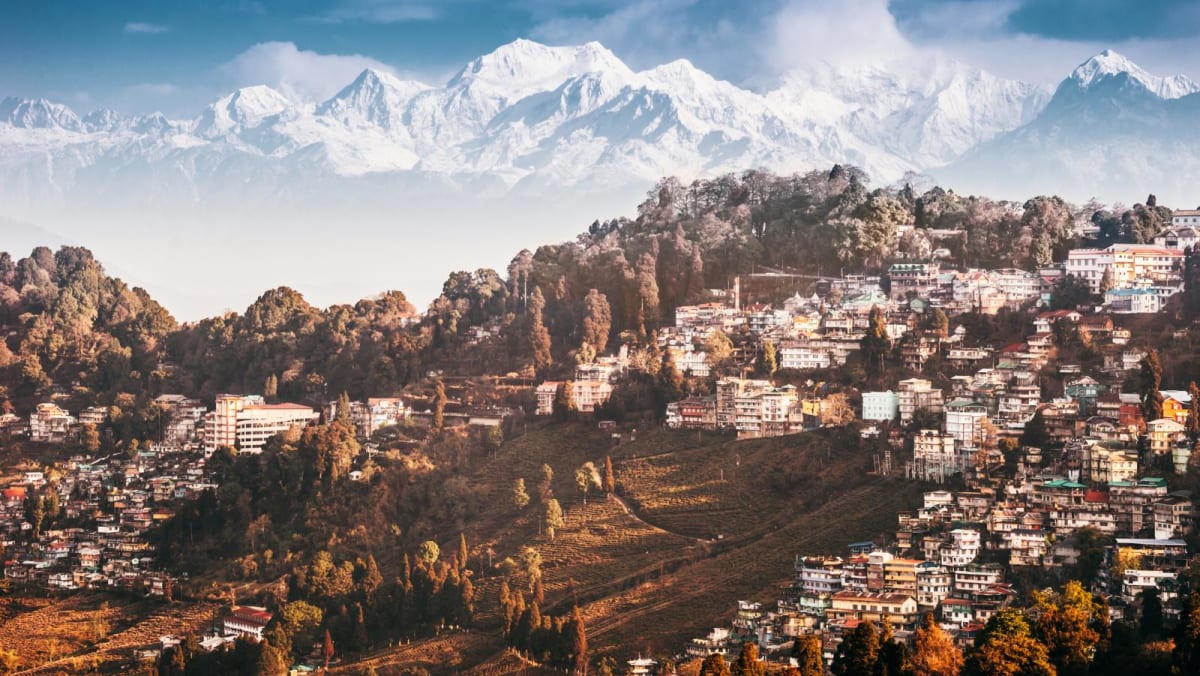Ever since I was a little girl I’d dreamed of going to Darjeeling. My imagination was captivated by this town nestled in the foothills of the Himalayas in the Indian state of West Bengal. Surrounded by lush, terraced tea gardens that extend across rolling hills, with the majestic snow-capped mountains behind them, Darjeeling is one of India’s most stunning hill stations, known as the Queen of the Mountains.
Originally set up in the 1800s as a summer retreat for British officials, it was leased to them by the Kingdom of Sikkim, and subsequently annexed to the British Raj in India. This history is still evident in its architecture and churches.
Our first stop was the Chowrasta – or mall – the heart of the old town on the Nehru Road. It’s a lively, bustling place:home to a promenade where tourists and locals alike come to shop, eat or simply sit and take in the views. For me it was a great chance to people-watch, sitting with a cup of tea and listening to young people singing Bollywood songs, families bargaining with the vendors and conversations between passersby.
We were staying at the Mayfair Hill Resort Darjeeling. The one-time summer retreat of the Maharajah of Nazargunj offered panoramic views of the surrounding tea gardens and snow-capped peaks. Mayfair Darjeeling is known for its colonial charm and old-world elegance. Its bright yellow buildings with their red roofs are perched on a hilltop overlooking the former summer house of the British governor during the Raj era.
Related:
Travel bucket list: Why are so many millennials flocking to Mongolia?
THE MAIL STATION
The next day we travelled to the village of Chimney, or Chimeni, home to the British army during the First World War. During the colonial period, they built the 24-foot-tall chimney for which the village was named. Once the heart of a building called the Dak Bungalow, the chimney is the only part of the structure that remains in the forest beside the beautiful village in the Himalayas.
“Dak” translates as “mail”: These bungalows provided accommodations for the English mail carriers during the colonial period, as well as offering lodging for the British Empire’s government officials whose role was to maintain the outposts of the East India Co. Inside the bungalow you’d find a khansama (cook) who would feed these officials during their stays – giving their name to the famous Anglo-Indian curry known as the dak bangla, or mail bungalow curry, which was traditionally lighter on spices to please the English palate.
Related:
Exploring Jiuzhaigou National Park, a UNESCO World Heritage site in the province of Sichuan, China
DAWN ON TIGER HILL
Seeing the sun’s first rays breaking over the snow-capped peaks of the mighty Kanchenjunga Mountain and Mount Everest has become a ritual among tourists. Because of the location of the sun, the best time to see this incredible sight is from mid-October to December or March to April, and you’ll want to leave early: Tiger Hill was about an hour and a half’s drive from our hotel and we made sure to arrive by 4am. You’d be surprised by how many people were there at that hour.
We also spent time at the Selim Hill Tea Garden, which borders the town of Kurseong and dates to 1870. Sitting at 4,000 feet above sea level, the estate is named after the tea plantation’s founder, called Selim Sahab by the locals. The current manager, Shahab Mallick, explained to me that the estate is 100 per cent organic and that it has moved away from the commercial model of other tea plantations in the area. Instead, they’ve created the Selim Hill Collective, with an inclusive, sustainable approach to tea growing that’s designed to preserve biodiversity and treat workers fairly.
The estate’s 240 permanent staff receive accommodation, social security and medical care and we learned about the whole tea-production process from start to finish: Plucking, weathering, rolling, drying, sorting and packing. Mallick showed me around the estate’s cottage, now inhabited by the owners. I was excited to learn that Rabindranath Tagore, the 1913 Nobel Prize laureate for literature, used to stay there.
Those who want to visit Darjeeling to be immersed in its tea culture can do so even more easily by staying overnight at a luxurious tea estate such as the Taj Chia Kutir Resort and Spa, the Glenburn Tea Estate, the Ging Tea House or the Singtom Tea Estate & Resort.
By Romy Gill © The New York Times Company
The article originally appeared in The New York Times.





